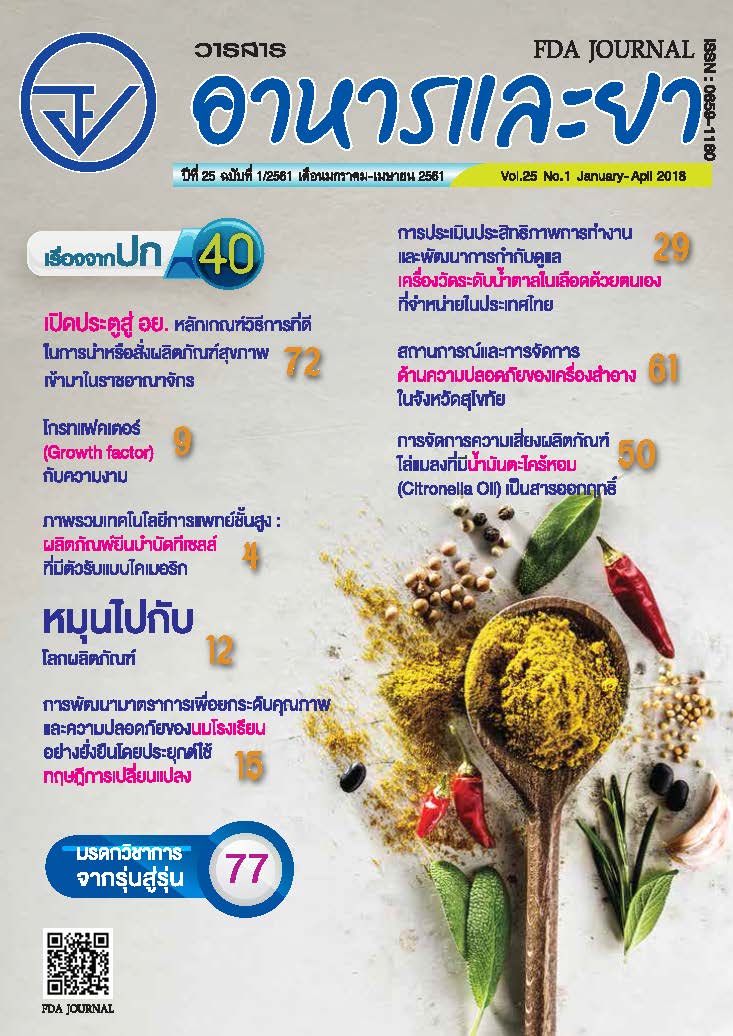การประเมินประสิทธิภาพการทำงานและพัฒนาการกำกับดูแลเครื่องวัดระดับน้ำตาล ในเลือดด้วยตนเอง ที่จำหน่ายในประเทศไทย
Main Article Content
บทคัดย่อ
โรคเบาหวานเป็นโรคเรื้อรังที่เป็นปัญหาสาธารณสุขระดับโลก การดูแลผู้ป่วยเบาหวานที่สำคัญคือการควบคุมระดับน้ำตาลในเลือดให้อยู่ในระดับใกล้เคียงกับปกติให้มากที่สุด ดังนั้นจึงต้องมีการประเมินประสิทธิภาพในการทำงานของเครื่องวัดระดับน้ำตาลในเลือดด้วยตนเอง (SMBG) เพื่อความปลอดภัยของผู้บริโภค และประสิทธิภาพของการรักษา วัตถุประสงค์ของการศึกษานี้เพื่อศึกษาความถูกต้อง (Accuracy) และความแม่นยำ (Precision) ของค่าระดับน้ำตาลในเลือดที่ตรวจวัดโดยเครื่อง SMBG ที่จำหน่ายในประเทศไทย และพัฒนาการกำกับดูแลเครื่องมือแพทย์ดังกล่าว การศึกษานี้เป็นCross-sectional study เครื่องที่จำหน่ายในท้องตลาดจำนวน 26 เครื่อง โดยการศึกษาความแม่นยำใช้สารควบคุมคุณภาพที่มากับเครื่อง และจาก third party การศึกษาความถูกต้องใช้เทียบผลระดับน้ำตาลในเลือดของเครื่อง SMBG กับเครื่องวิเคราะห์อัตโนมัติมาตรฐาน (Cobas 6000®) ผลการศึกษาความแม่นยำ (Intermediate precision) หากกำหนดเกณฑ์ที่ยอมรับได้โดยมีค่าร้อยละของสัมประสิทธิ์ความแปรปรวน ไม่เกินร้อยละ 5 ทุกระดับความเข้มข้นของน้ำตาล พบว่าจำนวน 2 เครื่องจาก 25 เครื่อง (ร้อยละ 8) เมื่อใช้สารควบคุมคุณภาพจาก third party และ 13 เครื่องจาก 26 เครื่อง (ร้อยละ 50) เมื่อใช้สารควบคุมคุณภาพที่มากับเครื่องของแต่ละบริษัท การศึกษาความถูกต้อง (System accuracy) พบว่ามี 3เครื่องจาก 26 เครื่อง (ร้อยละ 11.54) มีค่าระดับน้ำตาลที่ตรวจได้ไม่น้อยกว่าร้อยละ 95 ที่มีค่าอยู่ในช่วงเกณฑ์ยอมรับตามมาตรฐาน ISO 15197:2013 ซึ่งมีความเข้มงวดกว่ามาตรฐาน ISO 15197:2003 สำหรับการพัฒนาการกำกับดูแลเครื่องวัดระดับน้ำตาลในเลือดด้วยตนเอง สรุปได้ว่าควรมีการยกระดับให้เครื่อง SMBG เป็นเครื่องมือแพทย์ที่ต้องแจ้งรายการละเอียดตามมาตรา 6(2) แห่งพระราชบัญญัติเครื่องมือแพทย์ พ.ศ. 2551 เพื่อให้สอดคล้องกับการกำกับดูแลเครื่องมือแพทย์ตามระดับความเสี่ยงของสากลและข้อตกลงอาเซียนว่าด้วยบทบัญญัติเครื่องมือแพทย์ โดยมีการประเมินข้อมูลทางวิชาการด้านความปลอดภัยและสมรรถนะการทำงาน การแสดงฉลาก ก่อนอนุญาตให้จำหน่ายในท้องตลาด และมีข้อกำหนดให้ผู้ผลิตแสดงข้อมูลในการปรับค่าเครื่องให้มีความถูกต้องจากสารควบคุมคุณภาพ และจัดให้มีสารควบคุมคุณภาพที่ครอบคลุมระดับความเข้มข้นที่มีผลทางคลินิกพร้อมขณะจำหน่าย นอกจากนั้นควรมีการพัฒนาการประเมินทางห้องปฏิบัติการจากหน่วยงานทดสอบในประเทศ และเพิ่มความเข้มงวดในการกำกับดูแลหลังออกสู่ตลาด ติดตามการรายงานผลการทำงานอันผิดปกติ ผลอันไม่พึงประสงค์ที่เกิดขึ้นกับผู้บริโภค และรายงานการดำเนินการแก้ไข เพื่อจะได้กำกับดูแลให้ผู้บริโภคได้ใช้เครื่องที่มีประสิทธิภาพและความปลอดภัย ตลอดจนให้ความสำคัญกับการประชาสัมพันธ์ให้ความรู้แก่ผู้บริโภคในการใช้เครื่องได้อย่างถูกต้อง เพื่อให้เกิดประโยชน์ในการดูแลสุขภาพของผู้บริโภค
Article Details
เอกสารอ้างอิง
2.วิชัย เอกพลากร และคณะ. การสำรวจสุขภาพประชาชนไทยโดยการตรวจร่างกายครั้งที่ 5 พ.ศ.2557 ISBN 978-974-299-247-7 Retrieved December 4, 2016 from https://thaitgri.org/?p=37869
3.International Organization for Standardization. ISO 15197: 2003 In vitro diagnostic test systems – Requirements for blood –glucose monitoring systems for self-testing in managing diabetes mellitus.
4.Clinical Laboratory Improvement Amendments of 1988
5.International Organization for Standardization. ISO 15197: 2013 In vitro diagnostic test systems – Requirements for blood –glucose monitoring systems for self-testing in managing diabetes mellitus.
6.U.S. Department of Health and Human Services. Food and Drug Administration.(2016). Self-Monitoring Blood Glucose Test Systems for Over-the-Counter Use. Guidance for Industry and Food and Drug Administration Staff. Retrieved November 17, 2017 from https://www.fda.gov/downloads/ucm380327.pdf
7.European Union. Directive 98/79/EC of the European Parliament and of the Council of 27 October 1998 on in vitro diagnostic medical devices. Official Journal L 331, 07/12/1998 P.0001-0037. Retrieved December 5, 2017 from https://eur-lex.europa.eu/legal-content/EN/TXT/?uri=CELEX:31998L0079
8.The ASEAN Secretariat. (2015). ASEAN Medical Device Directive. Jakarta.
9.พระราชบัญญัติเครื่องมือแพทย์ พ.ศ. 2551. ราชกิจจานุเบกษาเล่มที่ 125 , ตอนที่ 43 ก (ลงวันที่ 5 มีนาคม 2551).
10.ประกาศกระทรวงสาธารณสุข เรื่อง หลักเกณฑ์ วิธีการ และเงื่อนไขการจัดทำรายงานผลการทำงานอันผิดปกติของเครื่องมือแพทย์ หรือผลอันไม่พึงประสงค์ที่เกิดขึ้นกับผู้บริโภค และรายงานการดำเนินการแก้ไข ลงวันที่ 22 มีนาคม พ.ศ. 2559. ราชกิจจานุเบกษา เล่มที่ 133 , ตอนที่ 102 ง (ลงวันที่ 4 พฤษภาคม 2559).


